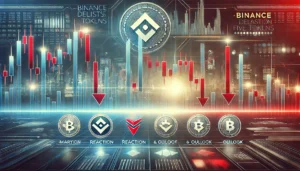The world’s biggest cryptocurrency exchange, Binance, has delisted five pairs of trading pairs, specifically GFT/USDT, IRIS/USDT, KEY/USDT, OAX/USDT, and REN/USDT. It will come into effect on December 10, 2024. This delisting brings a lot of volatility into the market as prices fall sharply for these tokens whose combined market capitalization falls below $100 million.
The delisting has rekindled discussions concerning the impact of centralized exchanges on smaller cryptocurrencies and the greater implication on market dynamics.
Price Movements Post-Announcement

Market responds instantly and strongly to Binance’s statement with all five tokens experiencing steep downfalls:
GFT/USDT
GFT declined 30% in the first 24 hours from the date of the delisting news. Technical indicators indicated a bearish market, with the Relative Strength Index (RSI) dipping to 28.71. This means that the level is highly over-sold. MACD signalled strong bearish momentum; this has been confirmed by the negativity from the trading community.
IRIS/USDT
IRIS fell 25%, below its 50-day moving average. Its RSI mirrored GFT’s, ending at 28.74, indicating oversold conditions. The MACD has a widening bearish divergence and is unlikely to bounce in the short term.
KEY/USDT
KEY was the worst affected, with a nearly 40% decline since the announcement. Its RSI dropped to 34.03, while the MACD confirmed a strongly negative trajectory. Such a sharp fall has left traders wary of further declines.
OAX/USDT
OAX has recorded the highest percentage drop in value, losing nearly 45% of its value. The RSI stands at 26.76, which indicates extreme selling pressure, and its technical indicators give little support to the prospect of a price rebound.
REN/USDT
REN was a little better but still went down 20%. The RSI was at 48.44, showing that although the token gets close to the oversold conditions, it has a relatively less bearish view than the others.
The sharp declines in all five tokens indicate the immense influence a centralised exchange like Binance has on the crypto space. In the absence of Binance’s significant depth and users, a slower recovery is anticipated for these assets.
Implications of Binance’s Delisting
Binance has said time and again that a delisting decision is triggered by factors such as minimal trading volumes, failure to meet technical requirements, and regulatory concerns. But that leaves the vulnerabilities of a smaller cryptocurrency exposed because visibility and liquidity on major exchanges make the difference between making or breaking their markets.
While these facts aren’t an isolated situation, historically, even high-value altcoins such as Ripple’s XRP and Cardano’s ADA have had limitations to trading or been de-listed in specific conditions with various causes, either of regulatory scrutiny or so due to market and regulatory circum stance this depicts that delisting would indeed act equally damaging with huge scale cryptocurrencies irrespective to those modest little cryptocurrencies.
Binance delisting decisions remind the larger trading community of the inherent risks involved in centralized exchanges. It may be convenient to access such markets, but the use of them has its vulnerabilities in the hands of a few to trigger massive disruptions.
Outlook for Affected Tokens

This delisting does a short-term dark picture on the five tokens. Removing those from Binance would simply mean that liquidity and exposure have severely been compromised. Most likely, many traders would begin to go for DEXs or other smaller sites, but they can’t afford the same level of liquidity and scale as Binance has, presenting challenges for adoption and price stabilisation.
The focus for the impacted projects would then shift to rebuilding community trust and finding alternative trading routes. Listing on other centralized exchanges or developing stronger ecosystems on decentralized platforms may help offset the effects. History shows that when delisted, Binance tokens often lack enough traction due to the lost reach of the exchange. As the crypto market matures, diversification across multiple exchanges and healthy communities may become increasingly important, helping projects survive a delisting decision.










